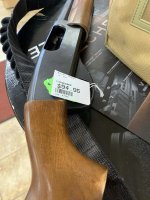[FONT="]Sometime around 1972, Smith & Wesson acquired the shotgun tooling of the defunct Noble Manufacturing Co. of Haydenville, Massachusetts, utilizing it to produce pump actions in various configurations as their Model 916 (also marked with the Eastfield name) throughout the remainder of the decade. [/FONT]
[FONT="]Below is a picture of one of mine, a 916A (this iteration having a fixed barrel; the 916T, though, did feature interchangeable barrels). This particular type with its 20" barrel and high capacity magazine is often described as the "tactical" version, although it's not clear if S&W ever used that term. Given its rifle style sights, some may consider this to be more along the lines of a "deer gun", although obviously in many jurisdictions it could be used as such only if a plug (and perhaps quite a long one) was installed in that magazine. [/FONT][FONT="]
[/FONT]
[FONT="]I've been reviewing some previous threads appearing on this forum regarding the 916's. While some members attest to having owned and shot them for many years without any issues, most noted that they suffered from persistent quality and reliability problems. There have been anecdotes posted regarding law enforcement agencies having purchased them, only to rather quickly switch to the Remington 870, or later adopting the Japanese made but Smith & Wesson branded Model 3000. [FONT="]One quirk that's been reported is that the shell lifter can malfunction so that when the slide is worked, the next live round, instead of being chambered, is ejected downwards through the loading port instead.[/FONT][/FONT]
[FONT="]Here's a link to the 916A's owners guide: [/FONT][FONT="]http://www.louiscandell.com/pdf/firearms/s&w_916a.pdf
[/FONT]
[FONT="]One thing you'll note in the instructions is how ridiculously complicated the disassembly (and by implication, reassembly) procedure is. In fact, insofar as I can tell from some online tutorials, the process is even more complex and tricky than it might at first appear. I wouldn't be at all surprised if many 916's have been damaged or otherwise put out of order on account of this.
[/FONT]
[FONT="]Below is a picture of one of mine, a 916A (this iteration having a fixed barrel; the 916T, though, did feature interchangeable barrels). This particular type with its 20" barrel and high capacity magazine is often described as the "tactical" version, although it's not clear if S&W ever used that term. Given its rifle style sights, some may consider this to be more along the lines of a "deer gun", although obviously in many jurisdictions it could be used as such only if a plug (and perhaps quite a long one) was installed in that magazine. [/FONT][FONT="]
[/FONT]
[FONT="]I've been reviewing some previous threads appearing on this forum regarding the 916's. While some members attest to having owned and shot them for many years without any issues, most noted that they suffered from persistent quality and reliability problems. There have been anecdotes posted regarding law enforcement agencies having purchased them, only to rather quickly switch to the Remington 870, or later adopting the Japanese made but Smith & Wesson branded Model 3000. [FONT="]One quirk that's been reported is that the shell lifter can malfunction so that when the slide is worked, the next live round, instead of being chambered, is ejected downwards through the loading port instead.[/FONT][/FONT]
[FONT="]Here's a link to the 916A's owners guide: [/FONT][FONT="]http://www.louiscandell.com/pdf/firearms/s&w_916a.pdf
[/FONT]
[FONT="]One thing you'll note in the instructions is how ridiculously complicated the disassembly (and by implication, reassembly) procedure is. In fact, insofar as I can tell from some online tutorials, the process is even more complex and tricky than it might at first appear. I wouldn't be at all surprised if many 916's have been damaged or otherwise put out of order on account of this.
[/FONT]




